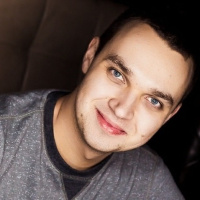Understanding Oracle Cloud Infrastructure
Oracle is confidently among the top 5 largest cloud service providers, along with such well-known corporations as Amazon, Google, and Microsoft. From this article, you will learn what OCI Oracle is, what tools it offers, in what areas it is used, and also become acquainted with its advantages and disadvantages.
Overview of Oracle Cloud Infrastructure
Oracle Cloud Infrastructure (OCI) is a cloud services platform available to users worldwide through a network of managed data centers of Oracle Corporation. It was launched in October 2016. It provides services within several models: Software as a Service (SaaS), Platform as a Service (PaaS), Data as a Service (DaaS), and Infrastructure as a Service (IaaS). OCI offers more than 100 cloud services, including servers, storage, databases, applications, business analytics, security, planning, deployment, and more.
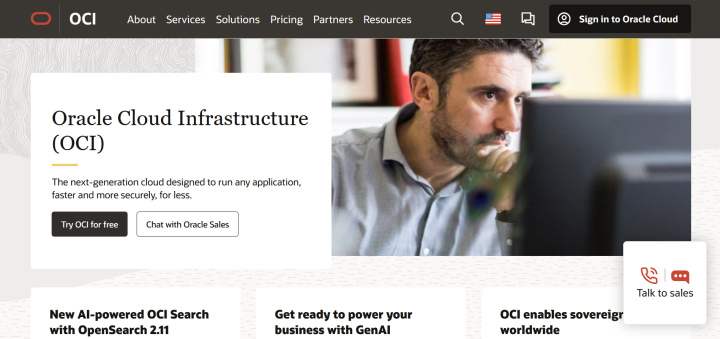
Oracle Cloud Services supports dedicated cloud, multi-cloud, hybrid cloud, and on-premises environments. They help customers build, deploy, manage, and automate enterprise systems and workflows. The platform is compatible with a range of open standards (REST, SQL, HTML5, and others) and open-source applications (MySQL, Spark, Kubernetes, Terraform, Hadoop, and others). It also provides support for a variety of databases, programming languages, frameworks, third-party systems, and applications.
You can connect to OCI via API through both virtualized multi-tenant deployments and physical compute services. Among other things, it provides access to an autonomous database, machine learning technologies, and load balancing. In principle, this information is enough for you to understand what Oracle Cloud Infrastructure is, in general.
- Automate the work of an online store or landing
- Empower through integration
- Don't spend money on programmers and integrators
- Save time by automating routine tasks
In terms of pricing, the vendor offers a pay-as-you-go model with no contract required. Users can calculate the cost of resources and capacity using the online calculator on the website. For example, renting a virtual machine with an AMD processor, 4 vCPUs, and 16 GB RAM costs $54 per month. Block storage (1x1 TB, 15K IOPS, 125 MB/sec) will cost $522 per month. 50 TB of throughput is $340 per month. A Kubernetes cluster (100 vCPUs, 750 GB RAM) is $1,734 per month. The subscription price includes corporate support. The Oracle Support Rewards program returns $0.25 to $0.33 for every US dollar spent on OCI.
Key Features of Oracle Cloud Infrastructure
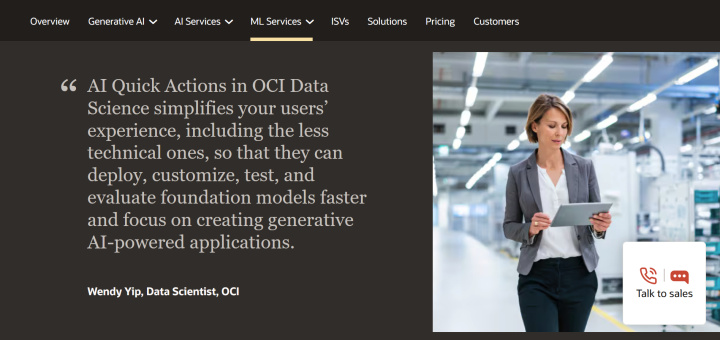
The Oracle Cloud Infrastructure as a Service (IaaS) platform provides a range of services:
- Compute. OCI delivers high-performance computing for any workload, including cloud and enterprise applications, compute-intensive, ML, and AI systems. Users have access to virtual machines (elastic, dense, optimized), Bare Metal instances (standard, dense, HPC), GPU instances, managed services for containers, API, and DevOps, as well as VMware Solution.
- Storage. The platform offers a variety of storage options, including block, local, file, and object. These can be used for databases, content, analytics, and other types of applications through common protocols and APIs.
- Network. The company's network infrastructure supports secure, low-latency, high-performance connections across the customer's virtual cloud network. Fully customizable IP addresses, subnets, routing, and firewalls are available to support new or existing private networks.
- Databases. OCI offers tools for data and database management, streaming workloads, and hyperscale big data. MySQL, NoSQL, and Oracle Autonomous Database can be deployed on-demand as managed cloud services, on-premises, and in multi-cloud environments.
- Application development. Developers have access to an open platform for creating, deploying, and managing applications of different types and formats. It supports cloud and container development, low-code development, and provides DevOps tools for CI and CD, Java application diagnostics, and integration with SaaS and on-premises applications.
- Integrations. OCI offers solutions for integrating on-premises and cloud applications. Its capabilities include integration, data migration and replication, API access management, integration analytics, and more. It connects multiple applications and data sources, including Salesforce, SAP, Shopify, Snowflake, and Workday.
- Business Intelligence. Oracle Cloud Analytics flexibly streamlines and analyzes every step of the analytics process, offering multiple ways to connect, prepare, and analyze data. The built-in business intelligence platform processes information from multiple applications, data warehouses, and data lakes, and then generates valuable insights based on it.
In addition to cloud infrastructure, the company supplies SaaS applications known as Oracle Cloud Applications. Designed for different systems and areas of activity, they have several deployment options.
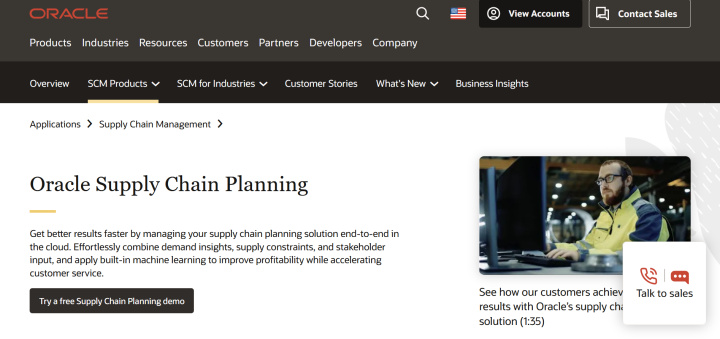
The most popular among them are:
- Customer Experience (CX).
- Human Capital Management (HCM).
- Enterprise Resource Planning (ERP).
- Supply Chain Management (SCM).
- Enterprise Performance Management (EPM).
- Internet of Things Applications (IoT).
- SaaS Analytics.
So, now that you have a general idea of what Oracle OCI is and what services it provides, let's take a look at its application areas and real-world use cases.
Applications and Use Cases
Oracle Cloud Infrastructure is successfully used in various areas: enterprise systems, data management and analytics, data security, the Internet of Things, edge computing, and more. This is eloquently demonstrated by real-life examples of how companies of various sizes and industries use OCI to solve their business problems.

Corporate Systems
Oracle (OCI) delivers powerful enterprise systems solutions that help companies optimize their operations and improve customer interactions. These tools provide the high reliability and flexibility required by progressive businesses.
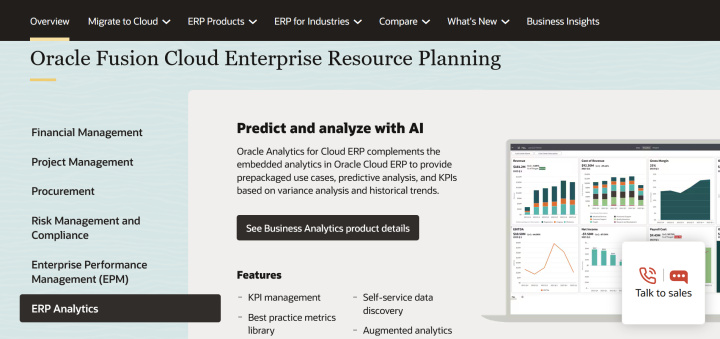
The platform has its own ERP (enterprise resource planning system) – Oracle E-Business Suite. In addition, it integrates with third-party applications (SAP).
- Use case. Using ERP to automate and optimize financial transactions, inventory management, and workflows in an international manufacturing company.
- Real case. GE Vernova (formerly GE Power, part of the multi-industry General Electric corporation) uses Oracle Cloud ERP and Oracle Supply Chain Management to optimize its supply chains and improve production and demand planning. The systems help the company consolidate multiple ERP systems into one. This improves forecasting accuracy and inventory management efficiency.
OCI technologies ensure stable operation of CRM. They guarantee its reliability and data integrity.
- Use case. Using Oracle CRM to personalize marketing campaigns and manage customer relationships in a large retail chain.
- Real case. International retailer Tesco used Oracle CRM to improve its omnichannel customer communication strategy by managing data and interactions across phone, chat and email.
Data Management and Analytics
Managing and analyzing large volumes of data requires reliable and scalable solutions provided by Oracle Cloud Infrastructure. These technologies enable companies to store, efficiently analyze and process data, and make optimal decisions based on relevant information.
Database hosting. Oracle Autonomous Database and its other DBMS solutions can be used in a high-availability environment.
- Use case. Deploying an autonomous Oracle database to support a large online bank's operations that require high performance and 24/7 data availability.
- Real case. One of the largest banks in Chile, Banco de Chile, uses Oracle Database for hosting and data management. This DBMS helps the bank process huge volumes of transactional data in real time, ensuring the smooth operation of its online services around the clock.
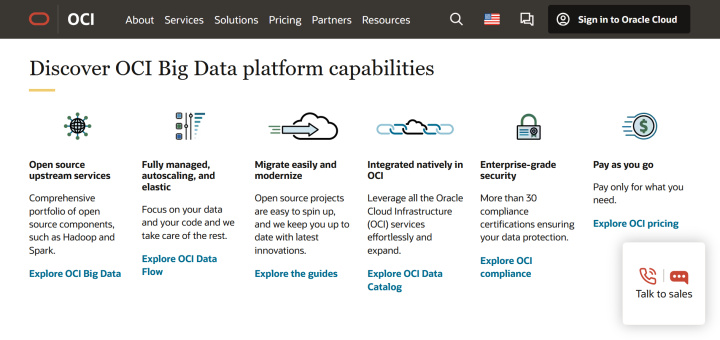
Big Data analytics. Oracle Big Data services provides powerful functionality for storing, analyzing, and visualizing large data sets.
- Use case. Using Oracle Big Data to analyze consumer behavior and optimize product range in a large retail chain.
- Real case. Lowe's, a major American retail chain, uses Oracle Big Data solutions to analyze data and optimize its operations. It uses Oracle analytics to manage supply chains, analyze consumer behavior, and improve the effectiveness of marketing campaigns.
Data Warehouse. Oracle Exadata service enables you to create high-performance solutions for storing information.
- Use case. Using Oracle Exadata to create a centralized data warehouse to serve the global operations of a multinational corporation.
- Real case. Samsung SDS, a subsidiary of a well-known electronics manufacturer, uses Oracle Exadata to store and process large volumes of products and manufacturing operations data.
Data Security
Data security and reliability are critical aspects for any business. Oracle Cloud Infrastructure offers comprehensive data protection solutions, including disaster recovery and backup, to ensure that your data is safe even in the event of a critical failure.
Disaster recovery. Host backup versions of sites in Oracle Infrastructure Cloud with quick switching to them in case of failure of the primary software.
- Use case. Setting up disaster recovery for the IT infrastructure of a large financial institution, ensuring minimal downtime in the event of failures.
- Real case. CERN (European Organization for Nuclear Research) uses OCI to provide high availability and disaster recovery for its critical data and IT infrastructure. This allows it to guarantee continuity of operations.
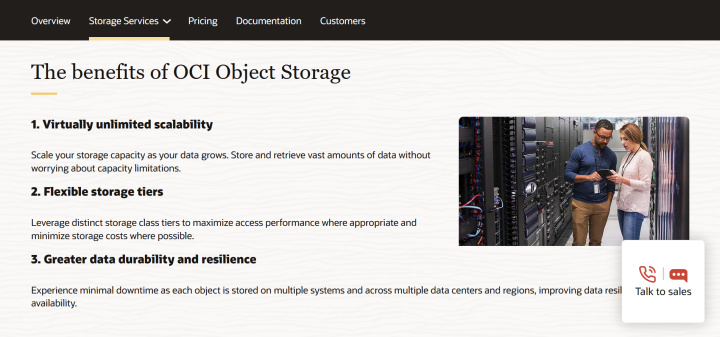
Backup and archiving. Cloud solutions for reliable and secure storage of backup copies and long-term archives.
- Use case. Using Oracle cloud solutions for backup and long-term archiving of critical scientific research data.
- Real case. NASA uses Oracle cloud solutions to archive and store massive amounts of astronomical data, including information from space missions and astronomical observations, for future research and analysis.
Internet of Things (IoT)
Oracle Cloud Infrastructure services are used extensively in the IoT space to collect, analyze, and process data from millions of devices worldwide. They help improve efficiency and optimize processes in industries ranging from smart cities to manufacturing.
Data collection. OCI IoT services efficiently collect and analyze data from various sensors and devices.
- Use case. Deploying Oracle IoT solutions to monitor and analyze equipment health in factories to prevent accidents and reduce downtime.
- Real case. Mitsubishi Electric, a major electrical equipment manufacturer, uses Oracle IoT Cloud to monitor the health of its industrial machinery and equipment. IoT services help it collect data from various sensors in real time, analyze it, and take preventive measures to prevent breakdowns and reduce downtime.
Smart City management. Using Oracle Cloud Infrastructure to coordinate and manage smart city infrastructure: optimizing street lighting and traffic, reducing energy consumption, and improving city services.
- Use case. Using Oracle Cloud to monitor and manage water supply and treatment systems in large cities to improve the quality of life for citizens and optimize resources.
- Real case. The city of San Jose, California, USA, uses Oracle Cloud solutions as part of its smart city initiative. They help the city manage data on water supply and other utilities. This helps improve the profitability of city services, enhance the quality of life for citizens, and optimize resource use.
Regulatory Compliance
Compliance with global standards and regulations is key for international businesses. Oracle Cloud Infrastructure provides powerful identity management and data protection tools to help companies comply with regulations such as GDPR and HIPAA.
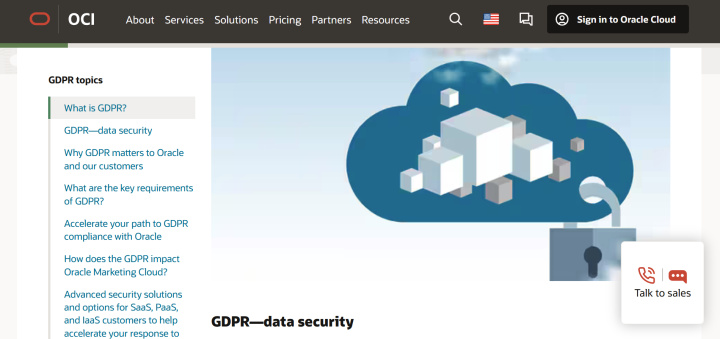
GDPR, HIPAA, and other standards. Oracle tools can be used to ensure the security and privacy of users' personal data in order to comply with regulatory requirements.
- Use case. Implementing Oracle Cloud to automate GDPR compliance in a global company processing customers' personal data.
- Real case. International telecommunications operator Orange S.A. uses Oracle Cloud solutions to automate the management of personal data of its customers worldwide. They make it possible to guarantee data security and comply with privacy standards stipulated by the requirements of the GDPR and other regulations.
Access and identity management. Oracle Cloud is used to automate identification processes and control access to information in large organizations. This allows organizations to meet information security and data protection requirements.
- Use case. Using Oracle Identity Cloud Service (IDCS) to manage employee access to confidential projects and data in a large IT company.
- Real case. IT company Mythics uses IDCS to manage user access and identity to protect its data and ensure compliance with security requirements.
Edge Computing
Edge computing opens up new opportunities for processing data at the edge of the network, where speed and responsiveness are critical. Oracle Cloud Infrastructure delivers high-performance, reliable edge computing solutions that improve data processing and service delivery with minimal latency.
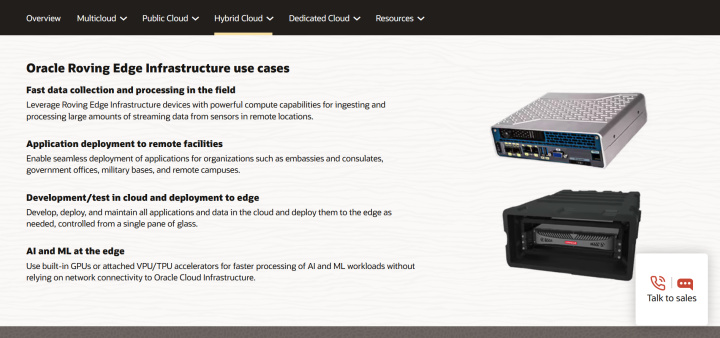
Low-latency services. Edge computing services make low-latency services more accessible to end users.
- Use case. Providing low latency and high-performance services for video conferencing under conditions of sudden increases in platform load.
- Real case. Zoom Video Communications, a communications technology company, uses Oracle Cloud Infrastructure to provide low latency and high performance for its video conferencing. This allows Zoom to efficiently handle the increased demand for its services and ensure users have a stable, high-quality connection without delays.
Manage data at the edge. Oracle Cloud at the edge enables enterprises to process and analyze data where it is generated, reducing latency and improving the performance of distributed systems.
- Use case. Using Oracle Cloud on edge computing devices to process data from energy facilities in real time.
- Real case. National Grid, a British multinational energy company, uses Oracle solutions for edge computing. It has implemented Oracle Cloud to process data from various devices and sensors installed at energy facilities in real time. This allows the company to quickly respond to changes in the energy grid, optimize system operation, and improve overall performance.
Benefits and Drawbacks
The numerous Oracle Cloud Infrastructure benefits make this platform one of the most well-known and popular cloud service providers. The most important advantages are:
- Architecture. Cloud services are delivered through a global network of data centers distributed across 50 geographic regions. Oracle Cloud's high-performance computing architecture is highly scalable, allowing its customers to flexibly expand their IT platforms.
- Performance. OCI resources are powered by advanced hardware, including powerful CPUs and GPUs, network infrastructure, and storage devices (NVMe solid-state drives). It can handle millions of read and write transactions per second. Oracle computing and storage systems deliver 2-5x higher I/O performance than their on-premises counterparts.
- Cost-effectiveness. Oracle OCI products can be competitively priced compared to other major cloud service providers such as AWS, Azure, and Google Cloud Platform (GCP). Flexible pricing allows customers to fine-tune the number of cores, memory, cloud storage, and other resources they need. Additionally, Oracle periodically offers discounts, credits for future use, and special offers that can help reduce cloud resource costs.
- Multi-cloud integration. Oracle Cloud easily connects to AWS resources through its own virtual private network services. It also has a multi-cloud approach to support Microsoft Azure.
Along with the undoubted advantages, Oracle Cloud Infrastructure services are not without some disadvantages. Cons of the system:
- Complexity of implementation for small and medium businesses. The platform architecture is quite specific and requires experience working with it. This is why its services are in demand mainly among large enterprises. Small and medium businesses often experience difficulties with their implementation.
- Limited ecosystem. Oracle has a smaller ecosystem of third-party applications (and a smaller community overall) than AWS and Azure. This is partly due to the relatively small market share that the platform occupies.
- Migration issues. Migrating systems from another cloud provider or from on-premises resources to OCI can be a complex, time-consuming, and expensive process.
- Proprietary technologies. Oracle provides its own database and middleware solutions. This lock-in is considered a disadvantage.
Conclusion
The balanced combination of price and functionality of Oracle Cloud services allows them to confidently and stably occupy a place in the top five best cloud providers for several years. A wide range of services and flexible pricing of the platform ensure its continued success among business clients around the world. The variety of service delivery formats and their high performance are key factors contributing to the choice of OCI. At the same time, certain shortcomings of the system limit its distribution and do not allow Oracle to displace the recognized industry leaders: AWS, Microsoft Azure, and Google Cloud.

